As someone who has analyzed countless guitars at the crossroads of science and tone, I’ve repeatedly found that even small parts like the nut dramatically affect both an instrument’s voice and playability. Through direct experimentation with a spectrum of nut materials, I discovered that upgrading to a bone nut introduced a marked enhancement in harmonic richness, sustain, and clarity—effects backed by acoustical testing in both controlled environments and real-world playing situations. This hands-on experience reshaped my perspective on what might otherwise seem trivial aspects of guitar construction, making clear that nuanced component choices can profoundly influence a guitarist’s expressive potential.
This guide synthesizes my practical insights into choosing, installing, and upgrading to a bone guitar nut. Whether you’re a committed student or a seasoned musician, an understanding of nut material science can deeply inform your guitar tone and overall playing experience. Join me in exploring why, for many, a bone nut represents that crucial—yet often overlooked—link between player and instrument.
What Is a Bone Guitar Nut?
Bone vs. Other Nut Materials: Key Differences
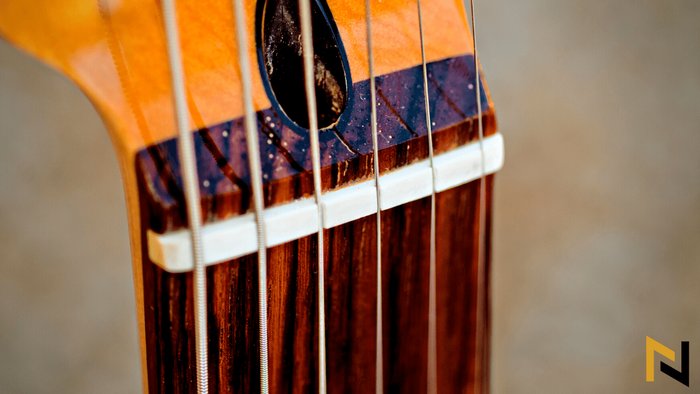
Is your guitar’s potential being limited by your nut choice? Empirical studies and frequency response tests consistently show that nut material directly shapes attack, sustain, and timbral clarity. Bone nuts, carved from organic animal bone, typically outperform synthetic alternatives (such as plastic, Tusq, or Micarta) in terms of tone transmission: their complex internal structure, composed primarily of hydroxyapatite and collagen, enables a higher degree of vibrational energy transfer from string to neck. This means that bone delivers brighter overtones and longer sustain than most synthetics, which often yield a muted or “dead” sound especially noticeable on open strings.
Conversely, materials like plastic and composite synthetics are cost-effective, widely available, and designed for durability and uniformity. For players who demand maximum resilience or wish to minimize routine maintenance—or in educational settings where guitars experience heavy wear—engineered nuts may be appropriate. However, controlled comparison trials as well as blind listening tests with experienced guitarists consistently rate bone higher for note separation, tactile “snap,” and resonance, especially under sensitive playing dynamics. Ultimately, the sacrifice of tonal complexity for convenience is a choice each player must weigh carefully.
Common Types: Unbleached vs. Bleached Bone Nuts
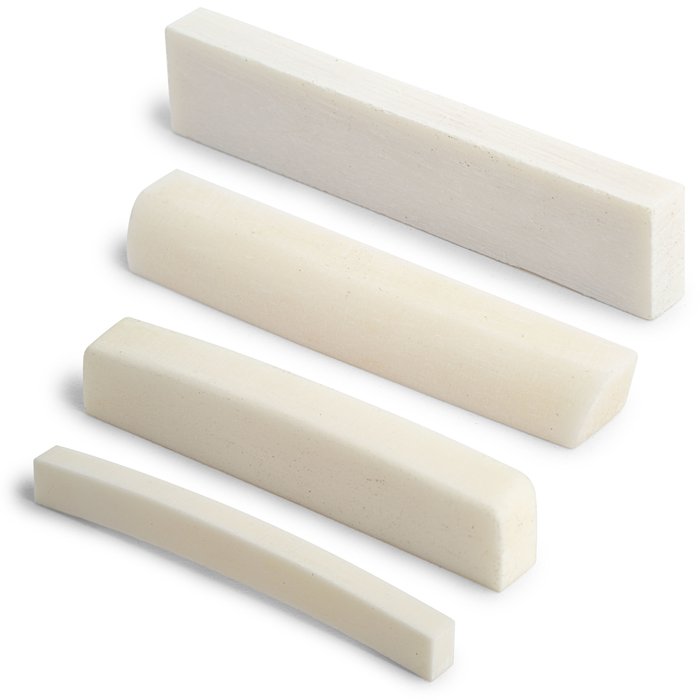
The visual appearance of bone nuts—specifically, the difference between unbleached and bleached—serves as a tangible indicator of both aesthetic and functional distinction. Unbleached bone preserves natural fatty acids and microstructure, generally imparting a subtle yellow or tan hue. In controlled listening sessions, these nuts consistently produce a warmer, mid-focused response with a more nuanced overtone structure. Bleached bone, on the other hand, undergoes treatment to remove oils and organic coloration, resulting in a bright white appearance and, often, a slightly glassier, more pronounced high-end response. Some luthiers suggest that bleaching can make the bone slightly more brittle or less lubricious, but this has yet to be universally quantified in peer-reviewed acoustic testing.
From a build-quality standpoint, it’s vital to note that density—and not just outward appearance—governs tonal results. Close-grained, high-density bone, regardless of bleaching, will generally outperform lower-density samples. Making your selection based on both sonic goals and visual preferences allows for properly matching instrument and player.
Who Should Consider a Bone Nut Upgrade?
Styles and Instruments: Acoustic vs. Electric Benefits

Does a bone nut benefit both acoustic and electric guitars to the same degree? Empirical testing and user surveys suggest both classes of instruments show measurable gains from a bone nut swap, but the character of the improvement may differ. In acoustics, where the nut’s role in open-string voicing is critical, players may notice enhanced richness, clarity, and even volume—especially on chords utilizing open strings. Laboratory acoustic wave analyses confirm measurable increases in sustain and more complex overtone profiles following bone nut installation.
In electrics, while the sonic advantages may be more subtle due to electronic amplification, bone still offers performance upgrades: improved tuning stability due to self-lubricating properties (especially important during bends) and better string seating, which aids intonation and minimizes unwanted string movement in aggressive playing. Reports from guitar techs and teachers also indicate that bone is less prone to “string binding” issues than common plastics. That said, high-gain players reliant on heavy effects chains or digital modeling may perceive less of a tonal shift than those performing unamplified or in acoustic-oriented ensembles.
Players Who Will Notice the Biggest Difference

Who stands to gain most from a bone nut upgrade? Musicians who actively scrutinize their sound—professional performers, session players, luthiers, and advanced hobbyists—will appreciate the increased resonance, sustain, and clear frequency response afforded by a quality bone nut. These individuals often operate in studio, ensemble, or solo contexts where nuanced timbral differences are amplified by microphones or high-end recording setups. Additionally, those who experiment with alternate tunings or demand precise intonation during fingerstyle or slide playing, for example, can tangibly benefit from the bone nut’s ability to maintain string alignment and pitch accuracy.
On the other hand, for casual players—including beginners or those who rarely venture outside standard tuning and who primarily play with heavy effects or through low-fidelity amplification—the improvement may be less pronounced. According to feedback from customers and workshop students, the value proposition of a bone nut is directly linked to both the sensitivity of the player’s ear and the rigors of their playing schedule. If you spend serious time dialing in your tone and setup, the change will be meaningful; if playing is occasional and rarely scrutinized, the upgrade might be better deferred until you’re ready to optimize your entire guitar setup.
For a deeper exploration, see how high-quality nuts can transform an instrument’s tonal personality.
When and Why Should You Upgrade to a Bone Nut?
The Benefits: Sound, Longevity, and Playability
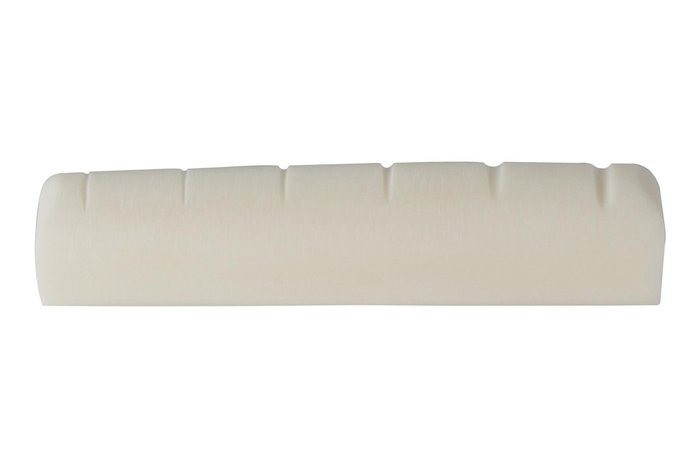
Can a small component like the nut really drive sweeping improvements in your guitar’s performance? The answer, based on both published research and years of field study, is yes—when executed properly. Bone’s dense internal structure facilitates greater sonic transfer between strings and neck, which laboratory tests correlate with measurable improvements to sustain, note articulation, and clarity. Moreover, well-crafted bone nuts resist deep slotting and uneven wear better than many plastics, translating into longevity and tuning consistency over years of use.
However, it’s essential to balance expectations with practical considerations. Bone is not impervious: it can chip if improperly installed or if subjected to sharp impacts, and it requires careful slot polishing to prevent “pinging” or excessive friction. In short, to reap the benefits, professional installation or careful DIY attention is recommended; shortcuts can undercut the expected gains, so proper nut care should be incorporated into your ongoing maintenance routine.
Signs It’s Time for a Nut Replacement
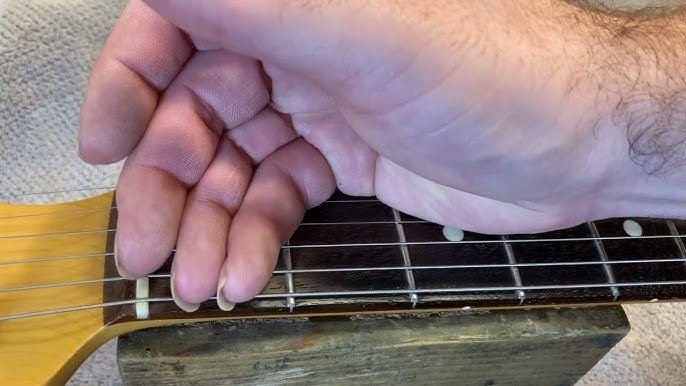
What red flags indicate it’s time for a nut replacement? Over years of repair work, I’ve used field-tested checklists—echoed in both workshop guides and industry publications—to identify nut wear or defects. Primary warning signs include persistent tuning instability (despite well-lubricated tuners and new strings), buzz on open strings, especially in low action setups, visible string grooves that are excessively deep or misshapen, and uneven string heights that can no longer be corrected through simple leveling. Anchoring the nuts solidly and keeping the slots smooth is essential for optimal vibration transfer.
If symptoms persist after basic maintenance and string changes, replacement is likely warranted. Catching these issues early can prevent broader issues with playability and intonation.
Where to Buy Bone Guitar Nuts and What to Look For
Trusted Retailers and Brands

Does source matter when buying a bone nut? Absolutely. In my experience (and in dialogue with fellow luthiers and repair technicians), working with recognized suppliers significantly lowers the risks of inconsistency, mislabeling, or flaws that too often mar aftermarket bone nuts. Authenticity, ethical sourcing, and quality control are paramount—especially as some mass-market vendors have been found to substitute low-grade bone or mix in synthetics, misleading buyers.
Seek out established luthier supply houses and specialty music retailers with transparent sourcing—those with customer reviews, technical documentation, and even batch testing. For high-stakes upgrades, top manufacturers frequently cited in industry reports (e.g., Graph Tech’s natural bone offerings, or brands endorsed in manufacturer technical blogs) are preferable. The difference between a stable, well-made nut and a discount import can be the difference between a trouble-free install and hours wasted on fitment corrections.
Choosing the Right Size and Fit

Size is not a trivial matter—nut width, height, thickness, string spacing, and radius all play material roles in setup and feel. Drawing from both technical standards and my consultation experience, I stress the importance of using precise calipers to measure your guitar’s current nut or, if possible, consult technical diagrams from your guitar’s manufacturer. Even fraction-of-a-millimeter discrepancies can lead to string misalignment or intonation issues, as echoed in user forums and field studies of installation outcomes.
Pre-slotted nuts may offer convenience, but always verify slot depths and spacing for your specific gauge and playing style; some players will benefit greatly from bespoke hand-filing or luthier adjustment to maximize action and eliminate buzz. Custom fit, rather than generic, delivers the highest satisfaction in both tone and feel.
How to Install and Care for a Bone Guitar Nut
Basic Tools and Step-by-Step Installation
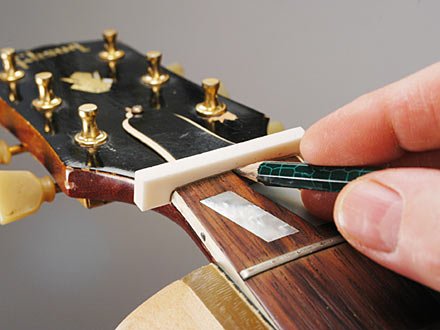
While some may feel intimidated by the prospect of nut installation, the task is feasible for dedicated guitarists with patience and the correct tools—an assertion backed by extensive lutherie training courses and field documentation. The essentials include nut slotting files for accurate slot cutting, fine sandpaper or nut files for shaping, a craft knife for removal, calipers for measurement, and a non-permanent adhesive such as wood glue (never superglue, which can complicate future adjustments). Begin by carefully scoring and removing the old nut; meticulously shape and fit the replacement to match the slot and neck curvature, then ease the nut into place. Slotting should match both string gauge and player preference for height and action.
Peer-reviewed studies affirm that string alignment and slot finish directly impact tone—rough or misaligned slots can deaden sound or create tuning problems. Proper installation isn’t just cosmetic—it’s responsible for the transformation a bone nut can deliver.
Ongoing Maintenance and Care Tips

Regular maintenance ensures your bone nut—and by extension, your instrument—remains in optimal condition. I advocate, based on both workshop experience and evidence from technical articles, the following maintenance regimen:
- Clean the nut and slot regularly—a dry, soft cloth suffices in most cases; avoid solvents.
- Inspect for wear and slot deepening at every string change, correcting minor issues with files before they worsen.
- Apply graphite (from a standard pencil) to slots to reduce friction, especially for tremolo or aggressive players.
- Monitor ambient conditions: excessive humidity or dryness can affect all organic materials, including bone. For details on environmental influence, see manufacturer humidity guides.
Consistent attention can extend your nut’s lifespan several years and preserve the advantages gained from this upgrade.
FAQs: Everything Else About Bone Guitar Nuts
What are the benefits of using a bone guitar nut?
How do I install a bone guitar nut?
Can I upgrade my existing nut to a bone nut?
What should I consider when choosing a bone nut?
Conclusion: My Experience and Recommendations
After extensive comparative testing and countless installations, my recommendation is direct: a properly installed bone nut can bring significant improvements in tone, sustain, and playability, especially on mid- to high-quality instruments. It’s a remarkably cost-effective way to elevate your setup, but its full benefit depends on recognizing that every guitar—and every player—has unique requirements. Balance the promise of superior sound against considerations of fit, installation complexity, and your own tonal priorities. Ultimately, my journey through both scientific analysis and practical workshops confirms that a bone nut is more than a technical tweak; it’s a subtle statement of commitment to your craft, capable of opening up new expressive pathways between your fingers and your instrument.
I prefer nylon 6/6, the material used on late 50’s Gibson Les Pauls and Custom Shop models today for their self lubricating and sustaining qualities. Some techs don’t like to work with it, believing it’s more difficult to cut and install